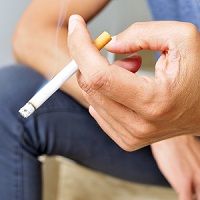News
Article
Psoriasis Severity Index Scores Impacted by Tobacco Smoking in Current, Former Smokers
Author(s):
In this analysis, the study investigators highlighted the impact of smoking cigarettes on PASI 75 achievement.

Cigarette smoking has a negative association with 75% Psoriasis Area and Severity Index reductions (PASI 75) among current and former smokers, according to new findings, with former smokers showing increased achievement of PASI 75 versus current smokers.1
This new research, led by Yan Qiang, from the Shanghai Skin Diseases Hospital at Tongji University School of Medicine in Shanghai, was carried out by Qiang and colleagues to expand upon the existing body of research on tobacco and psoriasis treatment efficacy. The investigators noted that smoking represents both an independent and a modifiable risk factor for psoriasis development as well as onset.
“However, evidence of the association between tobacco smoking and psoriasis treatment effects is still limited,” Qiang and colleagues wrote. “In this study, we aimed to understand how tobacco smoking influences the achievement of PASI75 after eight weeks of treatment, based on a cohort of psoriasis patients in Shanghai, China.”2
Background and Methods
The investigators looked at a cohort of psoriasis patients who had been treated at the Shanghai Skin Diseases Hospital between 2021 - 2022, noting that the prevalence of tobacco smoking in Shanghai was shown to be 31%. Those given a psoriasis diagnosis had been diagnosed using Chinese Clinical Dermatology guidelines and global standards.
The research team determined that their criteria for inclusion covered both male and female individuals with moderate-to-severe psoriasis with a body surface area (BSA) ≥ 5 and PASI ≥ 5, being aged 18 years and above, and having been admitted to the center’s inpatient department.
The team’s sample size they decided upon followed the methodology which they noted had been prescribed for observational research, and each individual with psoriasis underwent assessments such as physical examinations, PASI and BSA calculations, and physician global assessments (PGA) by dermatologists in hospital visits.
Later, dermatologists would formulate personalized plans of treatment for each subject through shared decision-making meetings, with treatment options such as methotrexate (MTX, 15–20 mg weekly with folic acid supplement), acitretin (25–50 mg per day), narrow-band ultraviolet (NB-UVB)/benvitimod (2–4 times per-week with benvitimod topical therapy), and biologics (e.g., risankizumab, ustekinumab, secukinumab).
Collection of data during the study involved the implementation of a specially-made questionnaire which dermatologists would administer. The investigators’ designed the questionnaire to cover demographic data such as sex, age, level of education marital status, body mass index (BMI), lifestyle habits like tobacco smoking, information on psoriasis severity (BSA, PASI, PGA), family history of the skin condition, and the treatment plan's efficacy looking at PASI scores at weeks 4 and 8, as well as reports of any adverse events (AEs).
Findings
Overall, there were 560 subjects who had been diagnosed with psoriasis and participated in the study, with 72.9% being male and the average age being 48.4 years. Within this population, 38.8% were shown to have been current smokers and 5.0% were former smokers.
The investigators reported that the participants’ baseline median PASI score had been 11.1 (interquartile range, IQR: 7.9–16.6), adding that this had lowered to 6.2 at the 4-week mark and further to 3.1 at the 8-week mark. They added that 13.8% and 47.3% of those with psoriasis reported achieving PASI 75 at the 4 and 8-week marks, respectively.
In the research team’s logistic regression analysis, they showed that those who were non-smoking showed a far greater likelihood of PASI 75 achievement at 8 weeks, with the adjusted odds ratio (AOR) being 11.43 (95% CI: 6.91–18.89) for those who were non-smokers compared to smokers.
Additionally, the team noted that the AORs were 14.14 (95% CI: 8.27–24.20) for those who were labeled current smokers and 3.05 (95% CI: 1.20–7.76) for those labeled as former smokers. Those who had formerly smoked also showed increased odds of achieving PASI 75 versus current smokers (AOR=3.37), and the investigators found that younger age at smoking initiation, longer duration of smoking habits, and higher smoking intensity were some of the elements linked to lower PASI 75 rates of achievement.
“We recommend the implementation of tobacco control measures, the provision of patient-centered, culturally sensitive cessation guides, and bedside support to improve the treatment response among patients with psoriasis,” they wrote.
References
- Qiang* Y, Kuai* L, Liu* S, et al. Tobacco smoking negatively influences the achievement of greater than three-quarters reduction in psoriasis area and severity index after eight weeks of treatment among patients with psoriasis: Findings from a prospective study. Tobacco Induced Diseases. 2024;22(April):61. doi:10.18332/tid/184143.
- Naldi L, Chatenoud L, Linder D, et al. Cigarette smoking, body mass index, and stressful life events as risk factors for psoriasis: results from an Italian case-control study. J Invest Dermatol. 2005;125(1):61-67. doi:10.1111/j.0022-202X.2005.23681.x.





